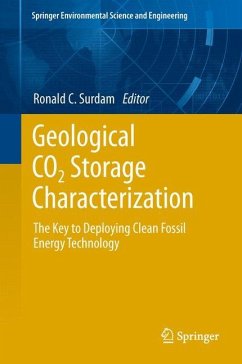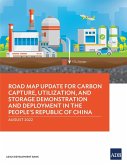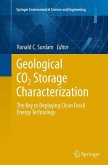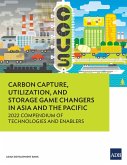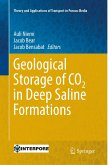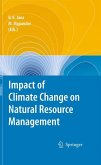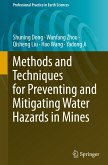Geological CO2 Storage Characterization
The Key to Deploying Clean Fossil Energy Technology
Herausgegeben:Surdam, Ronald C.
Geological CO2 Storage Characterization
The Key to Deploying Clean Fossil Energy Technology
Herausgegeben:Surdam, Ronald C.
- Gebundenes Buch
- Merkliste
- Auf die Merkliste
- Bewerten Bewerten
- Teilen
- Produkt teilen
- Produkterinnerung
- Produkterinnerung
This book investigates geological CO2 storage and its role in greenhouse gas emissions reduction, enhanced oil recovery, and environmentally responsible use of fossil fuels. Written for energy/environmental regulators at every level of government (federal, state, etc.), scientists/academics, representatives from the power and fossil energy sectors, NGOs, and other interested parties, this book uses the characterization of the Rock Springs Uplift site in Wyoming as an integrated case study to illustrate the application of geological CO2 storage science, principles, and theory in a real-world scenario.…mehr
Andere Kunden interessierten sich auch für
![Road Map Update for Carbon Capture, Utilization, and Storage Demonstration and Deployment in the People's Republic of China Road Map Update for Carbon Capture, Utilization, and Storage Demonstration and Deployment in the People's Republic of China]() Asian Development BankRoad Map Update for Carbon Capture, Utilization, and Storage Demonstration and Deployment in the People's Republic of China38,99 €
Asian Development BankRoad Map Update for Carbon Capture, Utilization, and Storage Demonstration and Deployment in the People's Republic of China38,99 €![Geological CO2 Storage Characterization Geological CO2 Storage Characterization]() Geological CO2 Storage Characterization105,99 €
Geological CO2 Storage Characterization105,99 €![How to Store CO2 Underground: Insights from early-mover CCS Projects How to Store CO2 Underground: Insights from early-mover CCS Projects]() Philip RingroseHow to Store CO2 Underground: Insights from early-mover CCS Projects45,99 €
Philip RingroseHow to Store CO2 Underground: Insights from early-mover CCS Projects45,99 €![Carbon Capture, Utilization, and Storage Game Changers in Asia and the Pacific Carbon Capture, Utilization, and Storage Game Changers in Asia and the Pacific]() Asian Development BankCarbon Capture, Utilization, and Storage Game Changers in Asia and the Pacific37,99 €
Asian Development BankCarbon Capture, Utilization, and Storage Game Changers in Asia and the Pacific37,99 €![Geological Storage of CO2 in Deep Saline Formations Geological Storage of CO2 in Deep Saline Formations]() Geological Storage of CO2 in Deep Saline Formations98,99 €
Geological Storage of CO2 in Deep Saline Formations98,99 €![Impact of Climate Change on Natural Resource Management Impact of Climate Change on Natural Resource Management]() Bipal K. Jana / Mrinmoy Majumder (Hrsg.)Impact of Climate Change on Natural Resource Management121,99 €
Bipal K. Jana / Mrinmoy Majumder (Hrsg.)Impact of Climate Change on Natural Resource Management121,99 €![Methods and Techniques for Preventing and Mitigating Water Hazards in Mines Methods and Techniques for Preventing and Mitigating Water Hazards in Mines]() Shuning DongMethods and Techniques for Preventing and Mitigating Water Hazards in Mines137,99 €
Shuning DongMethods and Techniques for Preventing and Mitigating Water Hazards in Mines137,99 €-
-
-
This book investigates geological CO2 storage and its role in greenhouse gas emissions reduction, enhanced oil recovery, and environmentally responsible use of fossil fuels. Written for energy/environmental regulators at every level of government (federal, state, etc.), scientists/academics, representatives from the power and fossil energy sectors, NGOs, and other interested parties, this book uses the characterization of the Rock Springs Uplift site in Wyoming as an integrated case study to illustrate the application of geological CO2 storage science, principles, and theory in a real-world scenario.
Produktdetails
- Produktdetails
- Springer Environmental Science and Engineering
- Verlag: Springer / Springer New York / Springer, Berlin
- Artikelnr. des Verlages: 978-1-4614-5787-9
- 2013
- Seitenzahl: 320
- Erscheinungstermin: 7. Dezember 2013
- Englisch
- Abmessung: 241mm x 160mm x 23mm
- Gewicht: 643g
- ISBN-13: 9781461457879
- ISBN-10: 1461457874
- Artikelnr.: 36275099
- Herstellerkennzeichnung Die Herstellerinformationen sind derzeit nicht verfügbar.
- Springer Environmental Science and Engineering
- Verlag: Springer / Springer New York / Springer, Berlin
- Artikelnr. des Verlages: 978-1-4614-5787-9
- 2013
- Seitenzahl: 320
- Erscheinungstermin: 7. Dezember 2013
- Englisch
- Abmessung: 241mm x 160mm x 23mm
- Gewicht: 643g
- ISBN-13: 9781461457879
- ISBN-10: 1461457874
- Artikelnr.: 36275099
- Herstellerkennzeichnung Die Herstellerinformationen sind derzeit nicht verfügbar.
Ronald C. Surdam has authored 240 articles in refereed scientific journals and books and has given more than 300 invited lectures. He founded and directed the Institute for Energy Research and directed the Enhanced Oil Recovery Institute at the University of Wyoming, and has consulted for many international energy and mineral exploration corporations. Over the past 45 years, Surdam has focused on oil and gas exploration, oil shale and trona depositional systems, coal and zeolite deposits in the Rocky Mountain Laramide basins of Wyoming and other states, and anomalously pressured natural gas accumulations and geological CO2 storage around the world. He has served the State of Wyoming in numerous capacities, most recently as Director of the Wyoming State Geological Survey. Currently, as Director of the University of Wyoming Carbon Management Institute and Principal Investigator of the Wyoming Carbon Underground Storage Project ($20 million), Surdam is helping lead the effort to accomplish commercial geological CO2 sequestration in the Rocky Mountain region. As a visiting professor at three Chinese universities, he is also assisting with carbon storage in the Shaanxi and Shanxi provinces of China.
Geological Observations Supporting Dynamic Climatic Changes.-The Story of the Wyoming Carbon Underground Storage Project (WY-CUSP), and the Regional Inventory and Prioritization of Potential CO2 Storage Reservoirs in Wyoming.-Legal Framework: Carbon Storage Regulations and Access for the Wyoming Carbon Underground Storage Project (WY-CUSP) .-A Strategy for Designing an Optimal Characterization Study of the Premier Carbon Capture, Utilization and Storage Site in Wyoming.-Regional Geologic History, CO2 Source Inventory, and Groundwater Risk Assessment of a Potential CO2 Sequestration Site on the Rock Springs Uplift in Southwest Wyoming.-Detailed Geologic Characterization of Core and Well Data from the Weber and Madison Formations and Associated Seals at a Potential CO2 Sequestration Site in Southwest Wyoming: Defining the Lithologic, Geochemical, Diagenetic, and Burial Histories Relative to Successful CO2 Storage.-Utility of 3-D Seismic Attribute Analysis and VSP for Assessing Potential Carbon Sequestration Targets on the Rock Springs Uplift, Southwest Wyoming.-Reservoir Fluid Characterization of the Weber Sandstone and Madison Limestone on the Rock Springs Uplift in Southwest Wyoming.-Predicting Permeability in the Targeted Geological CO2 Storage Reservoirs on the Rock Springs Uplift, Southwest Wyoming.-Advances in Estimating the Geologic CO2 Storage Capacity of the Madison Limestone and Weber Sandstone in the Rock Springs Uplift by Utilizing Detailed 3-D Reservoir Characterization and Geologic Uncertainty Reduction.-Displaced Fluid Management -the Key to Commercial-Scale Geologic CO2 Storage.-The Carbon Management Institute's Integrated CO2 Storage/EOR Strategy: the Advantages of Deploying Innovative, Multiple-resource Development Strategies Designed to Foster Sustainability of Energy and Environmental Resources.-A Feasibility Study of the Integration ofGeologic CO2 Storage with Enhanced Oil Recovery (CO2 Flooding) in the Ordos Basin, China.-Summary of the WY-CUSP Characterization Program.
Geological Observations Supporting Dynamic Climatic Changes.-The Story of the Wyoming Carbon Underground Storage Project (WY-CUSP), and the Regional Inventory and Prioritization of Potential CO2 Storage Reservoirs in Wyoming.-Legal Framework: Carbon Storage Regulations and Access for the Wyoming Carbon Underground Storage Project (WY-CUSP) .-A Strategy for Designing an Optimal Characterization Study of the Premier Carbon Capture, Utilization and Storage Site in Wyoming.-Regional Geologic History, CO2 Source Inventory, and Groundwater Risk Assessment of a Potential CO2 Sequestration Site on the Rock Springs Uplift in Southwest Wyoming.-Detailed Geologic Characterization of Core and Well Data from the Weber and Madison Formations and Associated Seals at a Potential CO2 Sequestration Site in Southwest Wyoming: Defining the Lithologic, Geochemical, Diagenetic, and Burial Histories Relative to Successful CO2 Storage.-Utility of 3-D Seismic Attribute Analysis and VSP for Assessing Potential Carbon Sequestration Targets on the Rock Springs Uplift, Southwest Wyoming.-Reservoir Fluid Characterization of the Weber Sandstone and Madison Limestone on the Rock Springs Uplift in Southwest Wyoming.-Predicting Permeability in the Targeted Geological CO2 Storage Reservoirs on the Rock Springs Uplift, Southwest Wyoming.-Advances in Estimating the Geologic CO2 Storage Capacity of the Madison Limestone and Weber Sandstone in the Rock Springs Uplift by Utilizing Detailed 3-D Reservoir Characterization and Geologic Uncertainty Reduction.-Displaced Fluid Management -the Key to Commercial-Scale Geologic CO2 Storage.-The Carbon Management Institute's Integrated CO2 Storage/EOR Strategy: the Advantages of Deploying Innovative, Multiple-resource Development Strategies Designed to Foster Sustainability of Energy and Environmental Resources.-A Feasibility Study of the Integration ofGeologic CO2 Storage with Enhanced Oil Recovery (CO2 Flooding) in the Ordos Basin, China.-Summary of the WY-CUSP Characterization Program.

